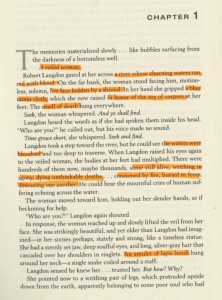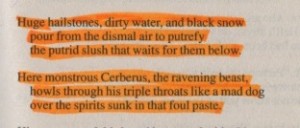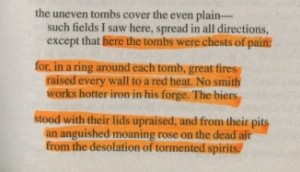 From the beginning of Chapter One of Inferno, Dan Brown uses parallelism to connect both his Inferno and Dante’s Inferno together. Robert Langdon is trapped in a nightmare where the “river whose churning waters ran red with blood [and] a sea of corpses” lies everywhere (Brown, 9). Throughout this passage, the motif of death is repeated over and over again in an attempt to recreate hell in Robert Langdon’s nightmare. From the Tania cloth, to the shroud, to a veil, clothes wore during a burial are emphasized. Even the Lapis lazuli amulet is correlated with death as ancient civilizations buried their dead with the gem, lapis lazuli. The royal Sumerian tomb of Ur has over 6,000 lapis lazuli sculptures while lapis lazuli was used in the mask of King Tutankhamen . Additionally, thousands of the bodies were still alive dying “unthinkable deaths [and] writhing in agony” in Langdon’s nightmare (Brown, 9). Robert Langdon describes how the bodies were killed, “consumed by fire, buried in feces, devouring one another” (Brown, 9).
From the beginning of Chapter One of Inferno, Dan Brown uses parallelism to connect both his Inferno and Dante’s Inferno together. Robert Langdon is trapped in a nightmare where the “river whose churning waters ran red with blood [and] a sea of corpses” lies everywhere (Brown, 9). Throughout this passage, the motif of death is repeated over and over again in an attempt to recreate hell in Robert Langdon’s nightmare. From the Tania cloth, to the shroud, to a veil, clothes wore during a burial are emphasized. Even the Lapis lazuli amulet is correlated with death as ancient civilizations buried their dead with the gem, lapis lazuli. The royal Sumerian tomb of Ur has over 6,000 lapis lazuli sculptures while lapis lazuli was used in the mask of King Tutankhamen . Additionally, thousands of the bodies were still alive dying “unthinkable deaths [and] writhing in agony” in Langdon’s nightmare (Brown, 9). Robert Langdon describes how the bodies were killed, “consumed by fire, buried in feces, devouring one another” (Brown, 9).
Each of theses deaths are punishments that are described in Dante’s Inferno.  The Third Circle is where gluttons are punished by being forced to lie in a vile slush or buried in feces.
The Third Circle is where gluttons are punished by being forced to lie in a vile slush or buried in feces.
The Sixth Circle is where heretics are punished by being trapped in flaming tombs.
 The Ninth Circle where Lucifer trapped in the frozen lake devours the betrayers.
The Ninth Circle where Lucifer trapped in the frozen lake devours the betrayers.
Each of the horrors that Robert Langdon witness are the punishments that Dante himself witnesses in his journey through Inferno.
